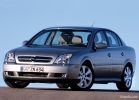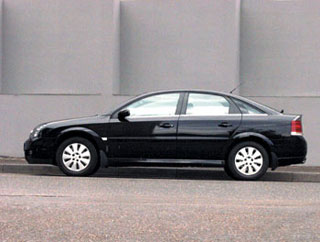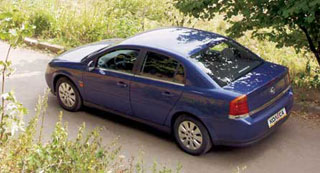Test drive Opel Vectra sedan 2002 - 2005 sedan
From myth to reality
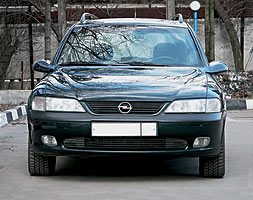 Among the German models-classmates, the vector is distinguished by a favorable price and low operating costs
Among the German models-classmates, the vector is distinguished by a favorable price and low operating costs Opel is not a car?
Great, take it!
Opel cars have never been distinguished by some outstanding consumer qualities or high image. But why then is Vectra one of the most popular middle -class models in Europe?
Firstly, at the time of its debut in 1995, the second-generation vector was a very advanced design. Fresh, to some extent avant-garde design, modern 16-valve engines, multi-link rear suspension, providing magnificent sled qualities. And the list of passive safety products, including full -sized frontal (and for the surcharge and side) pillows, protective bars in the doors, belt -dummers and pedaling during the accident, even today looks quite worthy. But most importantly, Vectra retained the main Opelly values \u200b\u200b- functionality and low operating costs.
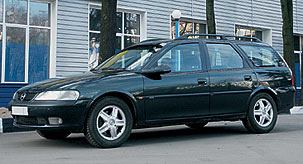 In Russia, the situation is different. From our democratic German cars, only Volkswagen recognizes, and for some reason, Opel is considered a second-grade brand. A strange thing - in Europe Volkswagen and Opel compete on equal terms, and for us Opel is not a car
In Russia, the situation is different. From our democratic German cars, only Volkswagen recognizes, and for some reason, Opel is considered a second-grade brand. A strange thing - in Europe Volkswagen and Opel compete on equal terms, and for us Opel is not a car However, if you are able to figure out that one of the two competing on equal terms cannot be good, and the other is bad, then a similar reputation of Opel is only at your hand. Judge for yourself.
The 1997 vector, which was brought from Europe, depending on the status, motor and configuration costs $ 8500-10,000, and 98 years old-$ 9500-11,000. For a German middle-class car, the price is simply dumping. And it is explained only by the fact that with such an image of Opel you simply can’t sell more expensive than vector. For the same reason, the branded Opelian technical centers are used to working with meager profit. Normally, they cost an average of $ 30, and some even have $ 25 - not more expensive than in a good unauthorized service. With spare parts - the same picture. The oil filter stands, do not believe, $ 2.8. A reinforced shock absorber from a package for bad roads is $ 80. If you buy details in independent firms offering original Opel spare parts, it is possible to find another 10-15%. With such prices, even the owner of a used vete can use an authorized service and original spare parts.
For comparison: the Passat of the same age costs about $ 3,000 (or 25%) more expensive, and in order to get the costs of service and spare parts comparable to it, you will have to abandon the services of a company -center technical center and the original details. In Europe, this situation is simply impossible.
It is better to refuse diesel
About 15-20 years ago, the main problem of Opelian models was the low corrosion resistance of the body. Actively rusted records, senators, omega and vector of the first generation. Vectra-II in this regard is clearly better. Small points of cosmetic corrosion are possible only after five years of driving in salt Moscow if the body is painted with ordinary enamel. Mechanics recommend choosing a metallic more resistant to salt and mechanical damage, and after the purchase, install the front sprayers so that the paint is not upholstered on the rear edges of the wings and on the thresholds.
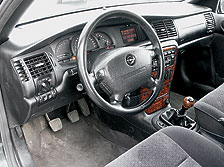
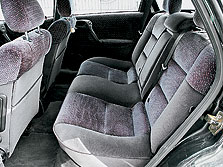
Another subtlety - checking the performance of the internal equipment of the body, pay attention to the central castle. If the head of the driver’s door is a hacking (rarely, but it happens), replace it immediately - a new one costs $ 150. Otherwise, soon you will have to change the five others, including the lock of the trunk lid and the gas tank hatch.
Diesel: the game is not worth the candle
Sometimes diesel vertors are found on the market. Until 1997, they installed a 1.7-liter turbodiesel, and then a 2-liter ecotek was replaced by him.
Unlike the popular Volkswagen diesel, 1.9 liters, Opelian diesel engines are extremely rare for us. And since they have never been officially supplied to Russia, the mechanics of authorized technical centers practically do not know them. Having bought such a car, you will become a stranger on a voluntary basis.
If you definitely need a diesel car, look for another brand. The same Volkswagen, for example.
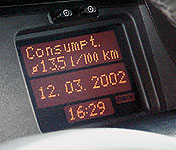
The screen of the on -board computer burns out in four years
On the dashboard you may be expected by a half -burned liquid crystal screen of the on -board computer and a constantly luminous signaling device for a safety pillow malfunction. The screen burns out about four years later. If you want to know the current time, the frequency of the radio station, fuel consumption, you will have to buy a new one for $ 150. But the alarm was most likely due to a violation of the contact in the connector under the driver's seat. This happens if the chair is often adjusted or some items are placed under it. After restoration of contact, be sure to go to the branded Ophevsky technical center to erase the cushion malfunction code from the computer. Otherwise, if necessary, it will not work. The gap 15-20 ago, the main problem of Opelian models was low corrosion resistance of the body. Actively rusted records, senators, omega and vector of the first generation. Vectra-II in this regard is clearly better. Small points of cosmetic corrosion are possible only after five years of driving in salt Moscow if the body is painted with ordinary enamel. Mechanics recommend choosing a metallic more resistant to salt and mechanical damage, and after the purchase, install the front sprayers so that the paint is not upholstered on the rear edges of the wings and on the thresholds.
Another subtlety - checking the performance of the internal equipment of the body, pay attention to the central castle. If the head of the driver’s door is a hacking (rarely, but it happens), replace it immediately - a new one costs $ 150. Otherwise, soon you will have to change the five others, including the lock of the trunk lid and the gas tank hatch.
Unlike the predecessor, the air conditioning on Vectra-II has become much more reliable. Only paired with a 1.6-liter 16-valve engine after 2-3 years, an unsuccessfully located air conditioner trunk loses tightness. Replacing the tube costs $ 205, plus refueling by freon.
Unlike the predecessor, the air conditioning on Vectra-II has become much more reliable. Only paired with a 1.6-liter 16-valve engine after 2-3 years, an unsuccessfully located air conditioner trunk loses tightness. Replacing the tube costs $ 205, plus refueling by freon.
Follow the timing belt !!!
It is unlikely that you will get a car with an 8-valve engine with a volume of 1.6 liters (75 l.) Or 2.0 l (115 l.). Both engines are easy to maintain and unpretentious, but were rarely installed on vector. Most likely, under the hood there will be a 16-valve with a volume of 1.6 liters (100 l.), 1.8 l (115 hp) or 2.0 l (136 hp). These engines of the Eco -Teke series have excellent characteristics, exemplary efficiency and, with proper operation, serve more than 300,000 km. The main thing is to monitor the timing belt that does not differ in durability.
Whatever is written in the instructions, the belt must be changed strictly after 60,000 km. You will be late, and he may not live to the next one that is carried out after 15,000 km. The belt will break out, the valves will meet with the pistons, and you will fly up to replace the head of the block assembly
Together with the belt, it is necessary to change the videos and, preferably, a water pump. Practice shows that it will live a little longer, and if you do everything in the complex, the work on replacing the pump will enter the price of replacing the belt: all together $ 330 with spare parts.
In our conditions, every second Ecootechnician engines requires replacing candles and cleaning injectors. If after that the engine continues to trumpet, inspect the candle insulators. Brown paths on their surface indicate that the time has come to change high -voltage wires and ignition coil. The kit costs $ 170.
Among other planned works, we note the replacement of the upper engine of the engine ($ 45) after 40,000-60,000 km and, about four years later, laying the valve cover that is drying out, and the oil begins to fill the candle wells. And further. In order to avoid overheating, make it a rule to remove the bumper annually and clean the engine radiator from dirt. Now - features of engines of various volumes.
The first conclusions about the condition of a 1.6-liter eco-library can be drawn even before a visit to the Opelian service for diagnostics. If, when giving out in place, the motor emits blue smoke, and there is an oily inception on the candles, then there is a problem. Perhaps the only thing is in the crankcase ventilation system over time and the issue is solved by the drilling of several holes in the valve cover partition. But in some parties of the 95-97 years, the problem was in the piston rings. Then with small blood it is impossible to do - there is a complete revision of the motor with the replacement of rings, oil -welded caps and valve grinding - $ 1300. Since the seller is unlikely to agree to open the engine at his expense, it is better to abandon the steaming machine immediately.
16-classmates with a volume of 1.8 and 2.0 liters are unlikely to expose you for a large amount, but by three years or by about 80,000 km they fail some engine control elements. If the car stalls when dumping gas or when switching to neutral, it means that the idle valve was locking ($ 160 original or $ 125 Bosch). He suffers due to the oil that enters the crankcase ventilation system. An additional oil reflector for $ 10 in the ventilation tube in front of the valve lid will solve the problem.
The same symptoms, plus difficult to launch, deterioration of the dynamics, increase in fuel consumption and sunbathing Check Engine, indicate the failure of the sensors of the position of the crankshaft or camshaft. Replacing any of them costs $ 100.
At first glance, there is enough trouble with motors. Did you think that Mercedes hand less? The main thing is that all possible ecoteca malfunctions are predictable by age or run and, with the exception of problems with piston rings on some copies of 1.6 liters, are eliminated by low costs.
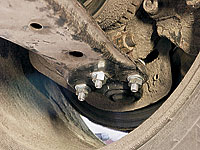
Ball supports change separately from the levers that saves your money
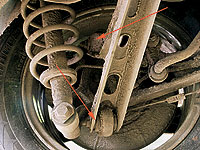
Silent blocks of the rear transverse levers (on the left; shown by arrows) are enough for about 60,000 km.
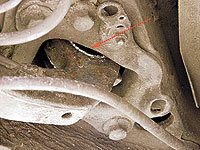
Silent blocks of longitudinal levers (right) are more durable
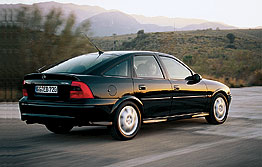 Options for execution
Options for execution Which sedan, hatchback and the wagon caravan is the question of your personal preferences. In any case, the vector is perceived as a solid German car, the interior of which is made of high -quality materials and is well thought out in terms of ergonomics.
Since the German system of choosing a configuration allows even the basic version to supplement with all kinds of custom -made equipment, we limit ourselves to the fundamental differences of three levels of execution. The basic GL means the fabric upholstery of the cabin. There are guaranteed two airbags, ABS, a central castle and a filter in the ventilation system. The CD option is much richer and more comfortable. It necessarily has mirrors and front windows with electric drive, tinted glass, tachometer and fog lights. True, all this could be ordered in GL. But the velor salon with the adjustment of the lumbar support in the front chairs, the leather steering wheel, the make -up mirrors with the backlight, etc., are impossible for GL.
The top version of the CDX differs from the CD with a wooden trim of the central console and the gearbox lever. A conditioner, cruise control, on -board computer and cast discs are installed here - for which it was necessary to pay extra in the simpler trim levels.
Choose a gearbox
With any of the engines of the eco -tech family, you can get both manually and an automatic box.
On the case of mechanics, it is useless to look for a drain plug. According to the instructions, the oil in it is flooded for the entire service life. However, in five or six years, it still loses its properties and it is better to replace it, and preferably branded Opelsky. The clutch serves for a long time - an average of 150,000-200,000 km, but to replace it, you have to disassemble half a month. In order not to do this twice, the clutch must be changed only with a set and, for preventive purposes, along with the rear oil seal of the crankshaft. The only age disease of the manual box is difficult switching after 150,000 km of run. It is treated with a replacement of a penny sleeve of the wings.
The Japanese 4 -speed automatic machine with electronic controls with three operating modes (economical, sports and winter) with proper circulation and change of oil after 30,000 km (according to the instructions after 60,000 km) is very reliable and durable. If something breaks in it, then only an electronic selector, or one or two control solenoids. In both cases, the cost of repair does not exceed $ 350.
Of the other features, we note an electronic anti -wings system, which was regularly installed with a 2.0 liter and 2.5 l V6 engines. The disconnection button with the TS symbol is located on the central console.
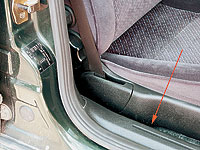
The identification plate in 1998 migrated from under the hood to the right central stance. VIN is duplicated on the floor under the plastic cover between the passenger seat and the threshold (shown by the arrow)
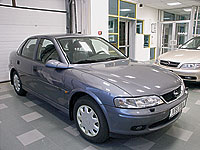
In 1999, the form of bumper changed, the radiator grille received a chrome edging, and headlights became transparent
Combining pleasant with useful
The excellent controllability of modern German cars on our roads often turns out to be a quick failure of complex suspensions. Driving qualities of vetera, even by today's standards, are very worthy. At the same time, the car has a surprisingly hard chassis.
Perhaps the only weak point in it is steering rods. After about 30,000-40,000 km, the backlash appears in the hinges connecting the thrust to the steering rack. A pair of original rods costs inexpensively - $ 70, but to replace you need to remove the engine subframe, which pours out in three and a half normally.
But the racks of the front and rear stabilizers - the expenditure details on most foreign cars - begin to tap only to 60,000 km. Approximately at the same time, external silent blocks of the transverse levers of the rear suspension are suitable. This is manifested in the suppleness of the rear wheels, if in the hanged state they shake them in a vertical plane.
In our conditions, by about 90,000 km, you will hear the knock of the upper supports of the front shock absorber racks. If the shock absorbers are still alive, a couple of supports will cost $ 100, and their replacement is $ 60. But, as a rule, by this time, shock absorbers are also getting tired and if there are another ten thousand with knocking supports, then $ 60 will cost replacement of both supports and shock absorbers. By the way, if you bought a car brought from Europe, it makes sense to install reinforced shock absorbers from a package for bad roads, which is regularly installed on vertors for sale in Russia. If funds allow, for $ 400 you can also buy reinforced springs. Then you will receive a completely Russian suspension with an increased 3 mm road clearance.
With brakes - no problems. Corpus even from Moscow salt almost never wedge, and discs do not have a tendency to beating and change after the third set of pads. The front hub bearings are almost eternal, and the rear departs only after strong lateral blows. True, the rear bearing is delivered assembled with the hub and the ABS sensor. The original assembly assembly costs $ 250, and exactly the same from SKF - $ 150. By the way, the same SKF will lie in the Ophevsky box. Silent blocks of the front levers? Up to 200,000 km they do not change them.
The idyll of reliability can only violate the steering rack in which a knock appears after 120,000 km. If you are not ready to spend money on a new one, you can put up with a knock for a long time. The main thing is not to try to tighten the rail, otherwise the steering wheel can bite in the bend.
So why is Opel worse than Volkswagen? The fact that Vectra breaks, I assure you, not more than the passat, but is much cheaper? In this regard, one joke is recalled:
- How much did you buy a tie?
- For a hundred dollars, at a discount.
- You are fool. I grabbed the angle around half the tower.
With this approach, Opel, indeed, has no chances
Vectra -V6 is expensive
A car with a 170-horsepower 2.5-liter V6 is found only in expensive CDs and CDX, as a rule, supplemented by a mass of custom-made equipment. In terms of comfort and prestige, this is a real business class in miniature. The fact that such a car is about $ 2000 is more expensive is understandable. But this is where your reckoning for prestige will not end.
The V6 motor also belongs to the Eco -Teke family, therefore, everything that is said about these engines with a volume of 1.8 and 2.0 liters is true, only with a fit for six cylinders and two block heads. For example, the replacement of the timing belt will cost not $ 330, but $ 550. You will pay not $ 100, but $ 200, etc. for a set of high -voltage wires. I'm not talking about the fact that in case of a belt break, you have to change two heads assembled ...
It should also be borne in mind that the heavy and powerful V6 times one and a half times reduces the service life of some parts of the suspension and transmission. In general, Vectru-V6 must be bought consciously. The principle turned up on occasion here is not appropriate.
Alexander Konov, photo Alexander Sadovnikov
A source: Magazine "Limousine" [05/02]





